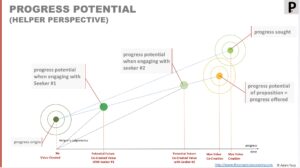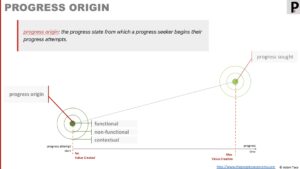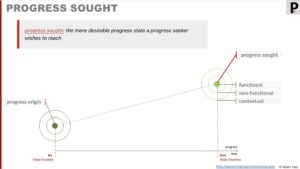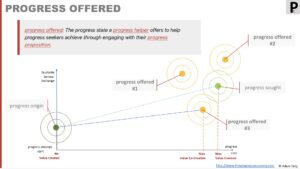What we’re thinking
We find it beneficial to name some specific progress states.
Firstly, these named states serve as waypoints describing a seeker’s journey on progress attempts.
Secondly, they help us explore and explain value in the progress economy; explaining Drucker’s famous quote:
Innovate or die
P. Drucker via “Innovation on the fly”, HBR
Without further delay, let’s delve into the five commonly used named states – progress sought, origin, offered, potential, and reached!
Naming states
We’re all about progress – moving over time to a more desired state. But where do we start? What is that end state? How do we judge where we are or how far do we think we can get?
Naming some specific states allows us to better describe progress. Here’s the five named progress states we’ll often refer to in the progress economy:
| description | |
|---|---|
| progress sought | the more desirable state a progress seeker aims to reach |
| progress origin | the starting point for the progress seeker in a progress attempt |
| progress offered | the progress state that a progress helper offers to assist the progress seeker reach when they engage with a specific progress proposition |
| progress potential | phenomenological judgement, at a specific point in time, of the progress state that could be reached in a progress attempt |
| progress reached | phenomenological judgement, at a specific point in time, of the progress state that has been reached during a progress attempt |
Let’s see how we use them.
Progress attempt waypoints
We can use named states to better describe progress. and visualise a progress attempt.
Simplistically, every progress attempt starts from a seeker’s individual progress origin and aims to end at their individual progress sought (their more desirable state). The seeker continuously makes judgements of progress potential and progress reached. And if engaging a progress proposition, the seeker judges if a proposition’s progress offered is sufficiently close to their progress sought.
Let’s take a quick overview of each of these named states.
Progress origin
Progress origin is the starting state for a seeker‘s progress attempt.
It moves over time as seekers gain resources from other progress attempts (including in other markets and industries).
Progress propositions also need to assume a progress origin. And helpers can segment progress origin to offer more relevant propositions.
Progress sought
We name the desired state a progress seeker wishes to reach the progress sought.
It also evolves over time due to seeker’s experiences, influences (even from other markets and industries) and changing circumstances.
For practical reasons we usually consider specific aspects of progress sought at a time rather than the totality.
Progress offered
A helper’s proposition offers to help a seeker reach a state of progress offered.
While it has a necessary connection to progress sought, it need not match it exactly.
Beyond simplistic progress sought, offering an exact match often requires customisation. That implies more effort on the helper’s part, which likely translates into a higher equitable exchange progress hurdle.
Helpers tend to offer propositions that target segments of progress sought to reduce that hurdle.
Some helpers look to deviate from a mainstream progress sought segment. Disruptive innovation and blue ocean strategy are two approaches that follow this idea.
It’s interesting to note that a helper’s progress offered is their view of progress potential.
Progress potential

The phenomenological judgement, at a specific point in time, of the progress state that could be reached in a progress attempt is the progress potential.
We can interpret this as judgement of future value that could be created and is judged prior to and during a progress attempt.
It is predominantly judged by seekers when deciding to engage a proposition as well as during attempts perhaps leading them to abandon.
For some progress attempts, helpers also judge potential of a particular seeker. They may decide to not make resources available if they judge it as too low.
Progress reached
Progress reached is the phenomenological judgement, at a specific point in time, of the progress state that has been reached during a progress attempt
It is judged during and after a progress attempt, predominantly by seekers. If they feel progress reached is not aligned with expectations they may abandon the attempt.
Like with progress potential, helpers sometimes make judgements on the seeker engaging the proposition. Potentially leading to resource withdrawal. Such circumstances may indicate value co-destruction.
Relating to value
Naming states generates no direct value itself to a seeker. But it helps us to reason about progress when creating propositions.
It also allows us to reason about value at various points during a progress attempt. For example, there is no value at progress origin since no progress has been made. However maximum value has emerged for the seeker upon reaching progress sought, since that is their desired state.
Relating to innovation
Since reaching progress sought realises maximum value for a seeker, innovation should primarily aim to increase seekers’ ability to reach their individual progress sought.
However we also need innovation to reduce hurdles to progress, ie maximise a seeker’s phenomenological judgement of progress potential (on their own or with propositions).
The ever evolving nature of progress sought and progress origins also drives helpers to innovate their offerings to stay relevant; and seekers to innovate with their existing resources. This is the driver behind Drucker’s famous quote:
Innovate or die
P. Drucker via “Innovation on the fly”, HBR






Let’s progress together through discussion…